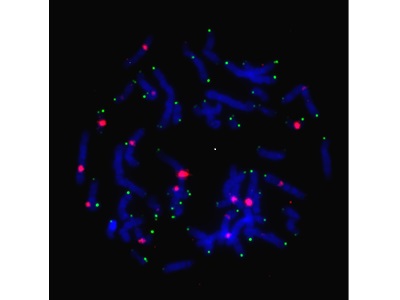Multiplexed in situ Signal Amplification with Splint Ligation Extension Probes
This innovation describes Splint Ligation Extension (SLX) probes, which are ssDNA probe reagents with a known length and sequence, that can be used to augment RNA FISH, DNA FISH, and IF methods. SLX probes enable absolute quantification of target nucleic acid or protein abundance.

What is the Problem?
Fluorescence in situ hybridization (FISH) and immunofluorescence (IF) enable the detection of the location and abundance of target nucleic acid sequences and proteins, respectively, in fixed cells and tissues. These technologies utilize enzymatic, hybridization-based, and chemical strategies to amplify target single-stranded DNA (ssDNA), such as Rolling Circle Amplification, Primer Exchange Reaction, and Hybridization Chain Reaction. Due to stochastic reaction dynamics, a polydisperse blend of different-length products is generated from these reactions, thus introducing non-uniformity into the signal intensities of fluorescent puncta that is unrelated to target abundance.
What is the Solution?
The solution is Splint Ligation Extension (SLX) probes, which are ssDNA probe reagents with a known length and sequence. SLX probes are synthesized via splint ligation of modular “building block” oligos and can be produced at scale using ssDNA amplification techniques. Current in situ omics technologies rely on stochastic amplification steps that produce non-uniform distributions of available binding sites for secondary fluorescent imager probes and thus non-uniform signal intensities of fluorescent puncta. SLX probes contain a known, uniform number of binding sites that is precisely tunable for secondary fluorescent imager probes, allowing the signal intensity to be tuned per target. This property can transform qualitative detection methods into quantitative detection technologies, increasing their power.
What is the Competitive Advantage?
The competitive advantage of this technology lies in its ability to enable absolute quantification of target nucleic acid or protein abundance using SLX probes that can be used in RNA FISH, DNA FISH, and IF experiments. Due to the customizable number of binding sites on the SLX probes, the signal intensity can be tuned for different targets with differing abundances to obtain relatively balanced signal intensities across a wide range of targets. SLX probes can also be produced at scales of 20-50x greater than the field standard “SABER” method. As the global spatial omics market is valued at $320.8 million in 2023 with an expected CAGR of 8.2%, there is a significant opportunity for this technology to advance the field of spatial transcriptomics and proteomics.